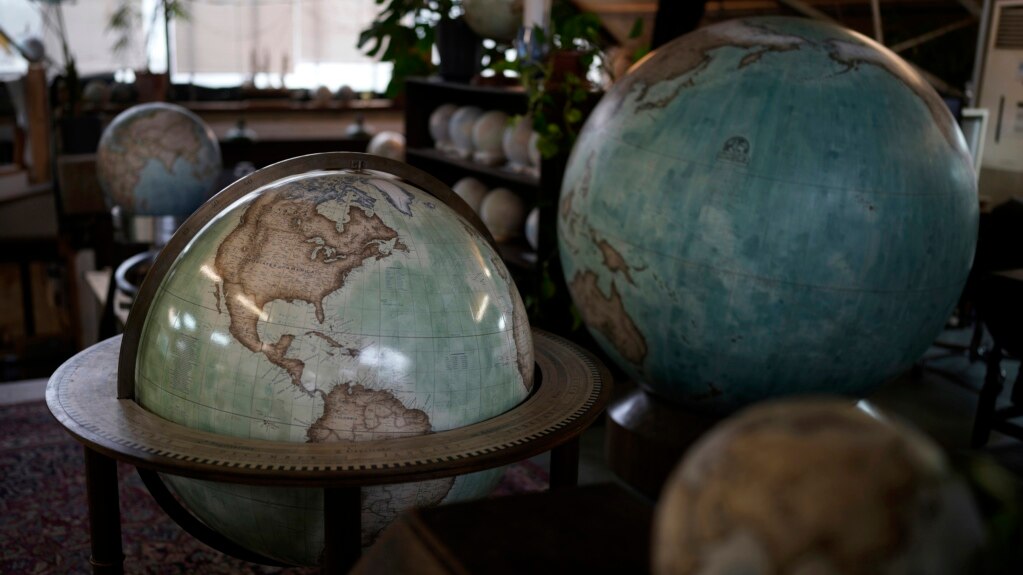Next time you see a globe, close your eyes, and turn it quickly so it spins. Then stop it with your finger.
Chances are that you will stop on a body of water. That is because water covers 71 percent of the Earth’s surface.
If you do not land on water, maybe you will discover a place you have never visited, or even knew about. Depending on the age of the globe, the place might be called something other than what it is called today. Politics changes national borders and city names over time.
You can use a globe to see what is on the other side of the world from where you are. Looking at a globe might make you think more about the April 8 eclipse, when the moon temporarily blocked the sun as seen from parts of the Earth.
Peter Bellerby makes globes in London. He thinks the human interest in finding “our place in the cosmos” is why globes remain popular. This is the case although computers and smart phones can tell us exactly where we are and where we are going.
Bellerby made a globe in 2008 for his father’s birthday. Although it cost a lot of money, the experience inspired him. He started a globe-making business. Sixteen years later, he has more than 20 people who work with him. They are artists, mapmakers and woodworkers.
“You don’t go onto Google Earth to get inspired,” he said. Bellerby’s studio is filled with globes in different states of completion. “A globe is very much something that connects you to the planet that we live on.”
Over time, Bellerby has also become an expert in world politics and borders. He said he often talks with officials in areas such as the Middle East, India, China and North Africa to be sure his globes have the correct markings.
There is also the question of whether globes are useful or only works of art. Because they must be started and completed, they will only be a picture in time. National borders, for example, change. A globe shows things as they were at the time it was made.
Jan Mokre is vice president of the International Coronelli Society for the Study of Globes in Vienna, Austria. Mokre said globes are important because people like to turn them, and the maps are artistic works. “Perhaps a certain nostalgia effect also plays a role, just as old cars and mechanical watches still exert a certain attraction on people,” Mokre said.
Joshua Nall directs the Whipple Museum of the History of Science in Cambridge, England. He noted that technology such as Google Earth gives students more information about the world. However, a physical globe shows “the learning, the erudition, the political interests of its owner.” Nall added that people are buying globes as beautiful things to have in their homes.
Bellerby’s globes are works of art. His small ones cost about $1,900 while the largest ones, which are more than one meter in diameter, can be tens of thousands of dollars. The company makes about 600 globes per year.
The process begins with the sphere itself and progresses to placing map pieces, called “gores,” on the globe. The gores fit together to completely cover the sphere.
Artists then work to decorate the globe with paint – using deep blue and green for the oceans and yellow, green and brown for the land. The designs can be complex. They can include mountains, sea creatures – even dragons.
Different kinds of people buy Bellerby’s products. They include people who want a family gift, political leaders, art collectors and movie studios. His globes have been in movies including Hugo and Tetris.
One of the 1.2-meter models, called the Churchill, is on display in a museum in Berlin, Germany.
While globes are works of art, Bellerby said, “Globemaking is a political minefield.”
For example, China does not recognize Taiwan as a country. Morocco does not recognize Western Sahara. India and Pakistan dispute their northern border. Many Arab countries, such as Lebanon, do not recognize Israel.
If Bellerby makes a globe for a foreign buyer, a mistake about a sensitive name or border could cause customs officials to hold up a costly sale. Bellerby’s artists mark disputed borders on the globe. He said: “We cannot change or rewrite history.”
History of globes
The oldest surviving globe dates to about 1492. It is called the Erdapfel which is German, for “Earth apple.” A German explorer who worked for the king of Portugal made the globe. It contains details such as where valuable goods could be found and trade rules. However, it does not show North or South America since Europeans did not yet know about them.
The German National Museum has the globe, known as the Behaim Globe for the explorer who created it. The museum notes that the globe shows “how much the creation of our modern world was based on the violent appropriation of raw materials, the slave trade and plantation farming.”
The museum calls the period “the first stage of European subjugation and division of the world.”
Two of the world’s most famous globes were created about 450 years later, for British Prime Minister Winston Churchill and U.S. President Franklin D. Roosevelt. They were each 1.2 meters in diameter.
The Weber Costello company near Chicago, Illinois created the globes with the help of 50 government geographers, mapmakers and draftsmen. The Roosevelt globe is at the former President’s library in New York and Churchill’s is in his family home in Kent, England.
Bellerby wrote that the globes were supposed to help the leaders make war plans during World War II. But, in reality, the gifts were “a simple PR (public relations) exercise, an important weapon in modern warfare.”
I’m Dan Friedell. And I'm Gena Bennett.

